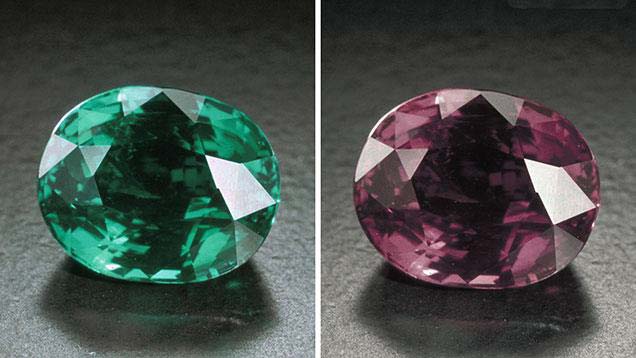Alexandrite

Discovered on the birthday of Czar Alexander in 1830, Alexandrite is the most valuable form of the mineral chrysoberyl, which also appears as cats eye or as an inexpensive faceted gem of an unusual greenish hue.
The fortuity of the discovery of Alexandrite on the Czar’s birthday was considered manifold because the colors displayed by this unusual stone mirror the imperial Russian colors red and green. When viewed under sunlight or fluorescent light, Alexandrite appears medium to bluish green, when seen by candlelight or incandescent light, it appears violet red.
This effect is not unique to Alexandrite, many gem types display color change (sapphire, garnet, apatite, tourmaline, obsidian, etc…) however the degree of color change exhibited by these highly valued gem stones is the most extreme ever encountered in natural gems.
This quality is best utilized in Alexandrite earrings, which can catch different light sources and truly show the vibrancy of Alexandrite’s color-change property. Alexandrite rings are also a popular option as it is a very tough stone. Its hardness is only transcended by rubies, sapphires and diamonds. Alexandrite cats eyes make particularly stunning signet rings and are a powerful display of a unique sense of style. In the cat’s-eye form, fine quality Alexandrite should be semi-transparent with a sharp exhibition of the white eye.
Since its discovery Alexandrite has rapidly grown in popularity, leading to the near depletion of the original Russian sources. Today the world’s major source of alexandrite is in the state of Minas Gerias, Brazil. In 1987, at the Lavra de Hematita mine, the world’s largest deposit of alexandrite was found. In 1993, another source of this extraordinary gemstone was found near the Tanzania-Mozambique border.
The degree of color change is the first and most important consideration when evaluating the value of Alexandrite. Low quality stones will present a less dramatic change of color, partially retaining some of the green color or appearing brown under incandescent light. The evaluation of Alexandrite should be performed in a dark room under a single light source (i.e. a candle or a light bulb).
